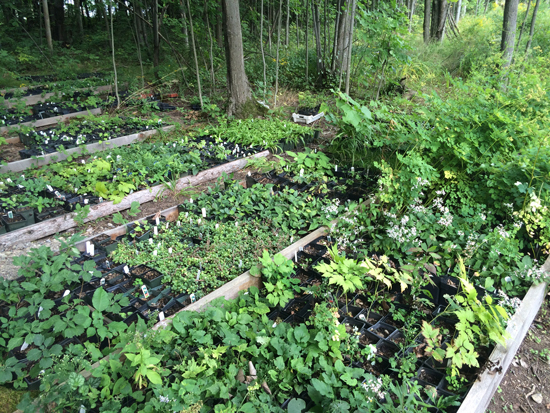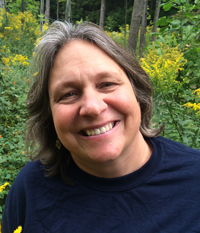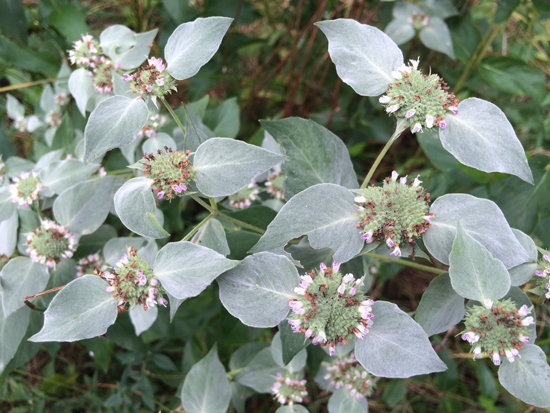story and photos by Michelle Sutton except where indicated

Native plants for shade at Amanda’s Garden

Ellen Folts
In 2016, Amanda’s Garden celebrated 25 years of growing and selling native plants in Livingston County. Raised in Lake Placid, Amanda’s owner Ellen Folts remembers hiking with her mother and aunts—lovers of wildflowers—in the vast forests of the Adirondacks. Folts recalls being transfixed by her first sighting of Dutchman’s breeches in the woods along the shore of Meachum Lake near Malone, NY. “I thought they were the coolest thing ever,” she says. As a teenager, Folts went out botanizing by herself with Peterson Field Guides. Her early passion for native flora set the course for her future vocation.
For 25 years, Amanda’s Garden was located in Springwater at Folts’s home property; the new location in Dansville officially opened in the spring of 2016. Folts and her husband Ron bought the new property in 2013 after carefully scoping out the site to make sure it would provide the right conditions for the nursery. She says, “We knew that this property typically keeps at least a foot of snow in the winter, which we need to protect overwintering nursery stock.”
The reason for the move from the Foltses home nursery to the Dansville location? The oak tree canopy at the home site had filled in; the dense oak shade was a problem for production as was the root competition from the oak trees with young plants in growing frames. Folts also wanted the acreage to make the nursery more of a destination, complete with hiking trails, a pond teeming with frogs, and abundant wildflower gardens featuring the more than 150 species she grows.
The extended Folts family, including daughter Amanda (30) (the nursery’s namesake) and son Cassidy (27), is key to the success of the operation. Family reunions are held annually in spring at the nursery, where the practiced hands of the volunteers do several days of potting and propagating while family get caught up with each other.
For this jamboree, they make their own potting mix from leaf compost, rice hulls, composted bark, and an organic preventative biological fungicide product that helps protect the roots from diseases. “We grow most of our plants from seeds or spores, rather than dividing them, to encourage genetic diversity,” Folts says. “In the case of the fern spores, we grow them in plastic containers on a light stand at home, then when they get potted up to 2 ¼-inch containers, we bring them up here to the nursery.” The nursery trays used for seed propagation are made from pressed peat, they’re compostable, and they last about three years. This is a strategic choice, because blue cohosh takes three years to germinate—the longest of any plants in her stock.
Folts grows from seed she collects—including seed on the nursery property, which sports many indigenous plants—and by buying from nurseries in the same
ecoregion, called the Laurentian. She grows mostly plants native to the Northeast, with a few outliers from further west as far as Illinois and south to North Carolina. “I limit the range so that I can keep the genetics found in the local ecoregion; I sell very few plants from outside that region.”
In addition to selling at the nursery and at Rochester’s Proud Market and Gathering of Gardeners symposium, Folts sells native plants online, orders that average $40-50 each, and ships them bare root. She also sells to nonprofits like state parks and land trusts; customers have included Central Park; Clark Reservation, Letchworth, and Knox Farm State Parks; the Chautauqua Institution; the Roemer Arboretum at SU NY Geneseo; and the Town of Perinton. Even though the paperwork was daunting, becoming a certified woman-owned business helped Folts secure large orders from New York State. Folts also teaches courses on all facets of native plants, with propagation as her favorite.
Jenny Apple, Associate Professor of Biology at SUNY Geneseo and Chair of the Spencer J. Roemer Arboretum Advisory Board, on Amanda’s Garden
I help maintain the Spencer J. Roemer Arboretum on the SUNY Geneseo campus. The Arboretum is a 20-acre woodland undergoing ecological succession since it ceased serving as pasture in the 1960s. As an ecologist interested in promoting biodiversity and controlling invasives, I have been eager to plant more natives in our Arboretum.Ellen came out to our site and prepared an excellent report providing recommendations for plants to use in different areas, ranging from the understory beneath a grand old oak tree, a more formal flower bed to be replaced with natives, and an open meadow dominated by exotics and aggressive perennials where we wanted to establish a diversity of plants to attract pollinators and monarchs.
She gave very thoughtful suggestions to ensure that floral resources for pollinators were available throughout the season along with a variety of colors and flower types for their aesthetic appeal. Thanks to her suggestions and the many plants we have purchased from Amanda’s Garden, our Arboretum’s gazebo garden is filling out nicely, with lovely colorful blooms from spring into late fall.
Ellen has been incredibly generous with her knowledge. In her consultation, she also provided strategies for trying to suppress invasives and unwanted vegetation and promote the success of our plantings. She pointed out plants we already had that we could collect seeds from for propagation on our own. At a workshop she gave at the Rochester Civic Garden Center on propagating native perennials, I learned many tricks and tips for collecting, prepping, and planting native seeds, which I put into practice with student volunteers.
My own yard has also benefited from her inventory and her great suggestions. I appreciate all her efforts to spread the word about the many benefits of native plants. I can’t get enough of observing and photographing all the incredible and beneficial insects they attract!
Laurie Hunt, Rochester
I was inspired to make my first trip to Amanda’s Garden because of a Facebook post saying it was National Pollinator’s Week. She gave me a tour of the grounds and everything pretty much looked the same to me, what most people might think of as weeds. I dubiously took home a few plants and started my love affair. Ellen did a home visit and identified which plants in my wooded backyard to keep and which to remove. She recommended plants to create diversity in the landscape. My yard is now primarily planted with native plants from Ellen and I keep adding more. People now come to me for advice! And I can’t walk in the woods without identifying native plants and pulling out invasives. It’s all Ellen’s fault.
Ryan Bass, Garrison
I’m an avid birder, and Amanda’s Garden has helped me design a bird-friendly garden. I’ve noticed a marked increase in birds in my native habitat garden vs. other areas of my property. It is no mystery that native plants attract insects and insects attract birds. Sometimes, public perception is “bugs are bad, so what can I spray on them?” In contrast, Ellen’s approach educates the customer on what plants are “larval hosts” to ensure butterflies and moths can sustain future generations. She recommends species that attract predator insects for those “problem” bugs. Finally, she promotes creating a diverse habitat (not a monoculture) to attract wildlife and foster a harmonious environment. I also have really valued her consultation on problem sites where so little will grow—dry shade, poor drainage, or areas of high deer browse. I’ve found that once established, if a native plant is sited in the right location, it is virtually maintenance free.

New England aster (Symphyotrichum novae-angliae) brings bold colors to the fall garden.

The delightfully showy wild ageratum (Eupatorium coelestinum)

Hart’s tongue fern (Asplenium scolpendrium)
A SHORT Q&A WITH ELLEN FOLTS
What do you recommend for those with construction-ravaged or otherwise infertile non-native soils, and what role does mulch play, if any?
Incorporate leaf compost or manure into the top 6” of soil and then mulch with a thin (no more than an inch) layer of compost or pine bark; you don’t want to mulch so deeply that you cause perennials to rot or you prevent plants from self-seeding. The fall leaf drop can stay atop your garden to provide insulation to your plants; in the spring, go out there and gently rake most of the leaves off and compost them. In that way, you keep the butterfly and other larvae that overwintered on the leaves on your property. (The few leaves that remain in the garden can contribute organic matter to the soil over time.) If you have spring ephemerals like Dutchman’s breeches coming up in March, be careful you don’t pull those right out when you’re raking. After raking each spring, put down a fresh inch of pine bark mulch to eventually break down along with the leaves.
What are some of the most underutilized native plants?
Mountain mint (Pycnanthemum muticum) grows in a beautiful mass and has a great smell. Barren strawberry (Geum fragarioides) can grow in sun or shade, it’s evergreen and makes an excellent groundcover, and it has little yellow strawberry-like flowers. It’s not particular about soil and it’s not invasive—it’s easy to pull up.Flowering raspberry (Rubus odoratus) has pretty flowers and handsome leaves. It can be invasive but for filling up a bank, it’s perfect. Canada anemone (Anemone canadensis) has beautiful white flowers and can take over a conventional garden but it’s great underneath a maple tree where it’s dry and you can’t get anything to grow, plus it attracts beneficial insects.

The underutilized mountain mint (Pycnanthemum muticum)
What are some of the easiest-to-grow, and some of the most particular?
The ones I call “the woodland staples” are fairly easy to grow if given some shade: ferns, sedges, wild geranium (Geranium maculatum), early meadow rue (Thalictrum dioicum), Jack in the Pulpit (Arisaema triphyllum), and wild columbine (Aquilegia canadensis). Joe Pye weed (Eupatorium maculatum) will grow anywhere, sun or shade it’s happiest in a ditch or other wet place, but in the hot dry sun it will just stay shorter. Marsh grass of Parnassus (Grassa parnassus) needs sandy soil and full sun, yet needs to be kept fairly moist. Hepatica (Hepatica americana) has to be on an incline— when you see it in the woods you’ll notice it’s always on its little hummock or hill. Without that, its crown will rot. The lilies like Turk’s cap (Lilium superbum) and Canada lily (Lilium canadense) you have to situate correctly—they like well-drained but moist soil and about two to three hours a day of direct sun.

The tiny, striking marsh grass of Parnassus (Grassa parnassus)
Photo by Ellen Folts
Can you tell us a few interesting things about your propagation techniques?
-We do most of our seed sowing in trays and leave them out all winter because many native perennials need stratification.
-The ferns we do in plastic boxes; we put half an inch to an inch of soil in there, moisten it, then sterilize the medium in the microwave for five minutes. When the medium cools down, we sow our spores using a piece of paper to gently tap them in. If the box gets contaminated by moss or algae we sometimes lose ferns, but you also have to be careful they don’t get too dry. We sow them in January and put them on a light stand; they’re not ready until two years later.
– Some plants like doll’s eyes (Actaea spp.) don’t even come up the first year and bloodroot (Sanguinary canadensis) sometimes comes up the first year, but sometimes doesn’t. We sow all of our woodland wildflower seeds, like those of bloodroot and trillium (Trillium spp.), as soon as the seed’s ripe, because a lot of them are hydrophilic and if they dry out, they will take an inordinately long time to germinate.

Fern propagation takes careful monitoring of light and moisture levels.
• • •
This article barely scratched the surface of Folts’s knowledge and offerings. To learn more about her and Amanda’s Garden, see amandasnativeplants.com.
Michelle Sutton (michellejudysutton.com) is a horticulturist, editor, and writer.
Views: 12




